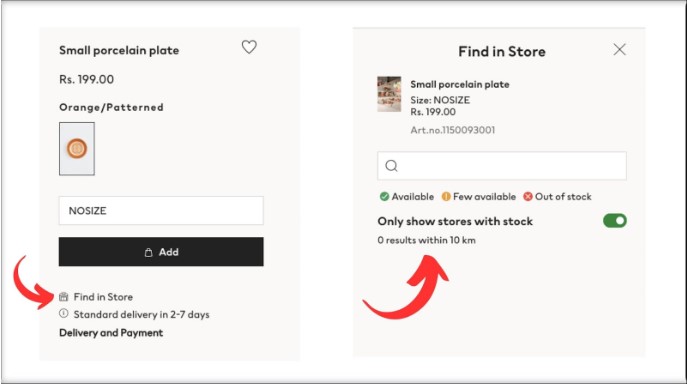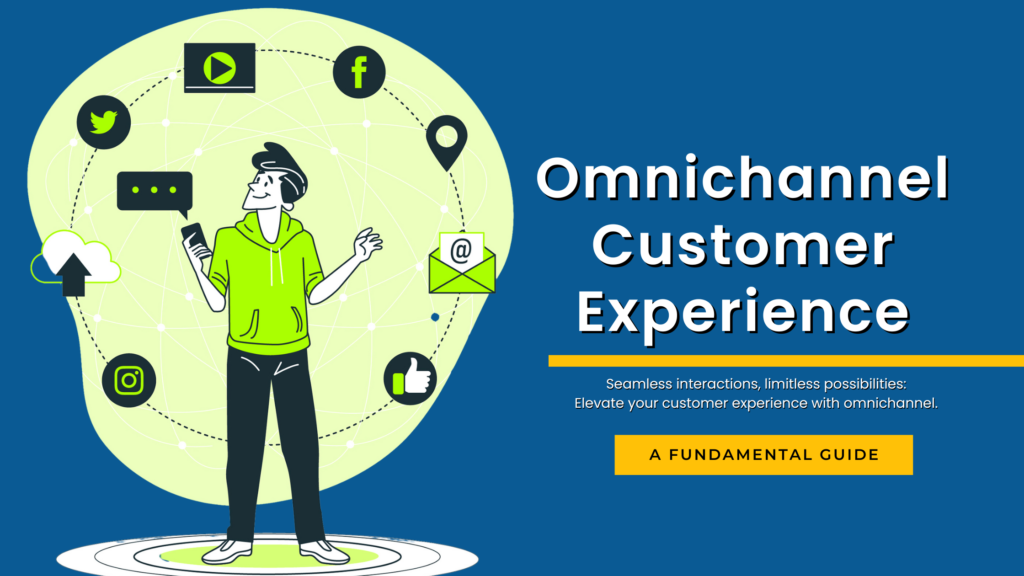Diversification is a key pillar of business growth. Many popular online stores, like legacy brands and fashion homes, started out offline. whereas online stores like Amazon and Glossier now have storefronts across the world.
But how synced is your business across different mediums and channels?
Can a person browsing your product online keep it on hold until they walk into the brand’s offline store and grab it themselves?
The omnichannel customer experience is about easing your customer in and offering them a chance to interact with your business across multiple channels.
 H&M has synced offline and online stores, so you can browse products across the channels and access your nearest stores’ stock information without stepping out of your home.
This seamless service is immensely rewarded by customers, who are more than likely to purchase from you when they have access to different touchpoints.
See the top 5 customer experience management trends to look out for in 2023.
H&M has synced offline and online stores, so you can browse products across the channels and access your nearest stores’ stock information without stepping out of your home.
This seamless service is immensely rewarded by customers, who are more than likely to purchase from you when they have access to different touchpoints.
See the top 5 customer experience management trends to look out for in 2023.
With multi-channel customer experiences, businesses adopt a different approach to customer interaction. Instead of streamlining its message and customer service, they leave it up to the different channels to pursue its customer interaction strategy.
There are many reasons why this is a popular practice. Starting with the fact that pursuing omnichannel customer service is hard. Joining all channels and delivering a consistent customer experience requires immense planning, strategizing, staff training, software investment, and more.
However, customers who love to shuffle through the channels before purchasing prefer an omnichannel customer experience. Anything less than absolute consistency can throw them off.
What is the omnichannel customer experience?
An omnichannel customer experience is the business practice of offering a similar customer experience and service to your buyers across different channels and mediums. This means that a customer browsing through your online store can seamlessly place stuff in their cart and go to your brick-and-mortar store without losing their purchase history and preferences. This also means that a customer can look up your business from their mobile app, move to their desktop browser, place products into their cart, and then make the final checkout from their tablet. Almost 90% of customers regularly switch between channels while shopping. Let’s take a look at this example from H&M! H&M has synced offline and online stores, so you can browse products across the channels and access your nearest stores’ stock information without stepping out of your home.
This seamless service is immensely rewarded by customers, who are more than likely to purchase from you when they have access to different touchpoints.
See the top 5 customer experience management trends to look out for in 2023.
H&M has synced offline and online stores, so you can browse products across the channels and access your nearest stores’ stock information without stepping out of your home.
This seamless service is immensely rewarded by customers, who are more than likely to purchase from you when they have access to different touchpoints.
See the top 5 customer experience management trends to look out for in 2023.
Omni-Channel vs. Multi-Channel
Omni-channel and multi-channel are ways businesses interact with customers across different channels. While omnichannel customer experience ensures that customers have a similar experience across platforms, multi-channel experience refers to the unique and unconnected customer experience across various channels. Let’s expand it here:| Omnichannel | Multi-Channel |
| Integrated and Consistent Customer Interaction | Unique customer interaction |
| dependent operation across channels | independent operation across channels |
| An integrated approach to customer interaction | non-identical approach to customer interaction |
| An identical strategy for customer experience | A unique strategy for customer experience |
How Does Omnichannel Work?
Here is the most common and step-by-step process for how omnichannel works: Step 1: You see an advertisement for a pair of jeans on your way to work. Step 2: You reach your desk and browse for that pair of jeans online. Step 3: You notice that the brand has a local store nearby your home. Step 4: You reserve the jeans on your phone and schedule a pickup. Step 5: When you reach the store, you notice a shirt that you like and ask for it to be sent to you for trial. Step 6: The store does not have the shirt in your size, so you ask the retail agent to deliver it in the right size to your home address. Step 7: Later in the day, you receive the parcel at your home (the delivery is quick because the store is nearby). Step 8: You are happy with the new pair of jeans and shirt, and you are ready to tell all about this experience to your friends. This is the clearest example of an omnichannel customer experience, although it goes beyond this single-day exchange.What are the Benefits of an Omnichannel Customer Experience?
Before we spill the beans on how you can incorporate an omnichannel customer experience in your business, let’s first learn about the benefits of an omnichannel customer experience:1. Consistent customer experience
The customer is king! And getting a consistent experience across channels is how they wish to be served. When you have an omnichannel strategy, customers are served uniformly, regardless of the channel they are on. This consistency boosts your connections and drives users to the checkout counter. For example, Starbucks often hands out free rewards cards you can cash in whenever you want to make a purchase. But unlike stores such as Walmart, you don’t have to be physically present to use your coupon. You can scan the card via your phone when ordering Starbucks delivery through Doordash and reload your card via the Starbucks website or app. Any change you make to your profile is updated across the channels within seconds. Takeaway: Consistent customer experience across channels signals a reliable and stress-free surfing and shopping experience.2. Customer retention and loyalty
You must know that retaining new customers is 5 to 25 times cheaper than acquiring them. Repeated purchases from a single wallet are the bedrock of your business. In return, satisfied customers become personal marketers and cheerleaders for your business. When customers feel served by your company, they spread the news to their friends and communities. The importance of an omnichannel customer experience cannot be understated. It is the pinnacle of customer service and drives customer retention by 57%. As a business owner in today’s economy with stiff competition, you cannot take this for granted. Every conversion is important, and every dollar pushes you ahead. The omnichannel customer experience creates happy and satisfied customers, which become your business’ marketing pillars.3. Customer engagement
Not every platform is right for every customer. We know that 47% of searches begin on Google. Your brand’s website carries half of your leads and prospective customers to your business. Once they’ve moved on to an app, their experience shouldn’t be muddied by an un-synced account, lost browsing history, or absent customer care. 85% of customers prefer a blend of channels, regardless of their primary preferences. With the right omnichannel customer care, buyers feel safe and taken care of, regardless of the platform they’re on. The easy switch from phone to store and back to the phone engages them in a way that builds brand confidence and long-term trust.4. The Customer Journey
A holistic customer journey includes keeping track of customer activity across channels and harnessing a comprehensive view of their online behavior. There are various tools and tricks to get this done, but this ultimately means that you need to follow your customer, and the best way to do it is by having a consistent omnichannel marketing strategy across all the platforms.5. Differentiates your brand
Standing out and nailing a USP is one of the most potent marketing strategies ever. You can use omnichannel customer service to differentiate yourself. Less than 20% of companies have adapted it, and you can join them.How to Build an Omnichannel Customer Experience
There is no right way or ideal process for implementing an omnichannel customer experience strategy. However, there are some crucial steps that you must take while building an omnichannel customer experience. You can create a seamless omnichannel customer experience in four easy steps:- Realign your online presence
- If you have inactive accounts on social media platforms, you need to resurrect them.
- If your response time on live chats is slow and dried out, you must reprimand that.
- If you have negative reviews on the sales pages, you need a response strategy for them.
- Create a uniform promotional strategy.
- Physical store
- Catalog
- Brochure
- Website
- Mobile Application
- Paid campaigns
- Broadcast marketing
- Social media
- Train your staff.
- Invest in technology.
What are the Tools for an Effective Omnichannel Customer Experience?
The essence of a flawless omnichannel customer experience lies in customer care, and many tools can help you achieve that. Let’s explore some of them:- Customer Relationship Management (CRM) software: CRM is a centralized platform for customer data management. It helps you track all customer behavior, past purchases, cart history, and browsing data. This data is used in your marketing campaigns to provide a personalized experience for the customer.
- Chatbots: Chatbots are around-the-clock automated messaging tools that can provide quick and programmed responses to customer queries. They effectively convey answers to common and repetitive questions and ensure a quick response to customers, regardless of the time of day.
- Marketing Automation Software: Marketing automation software spreads information and relays marketing campaigns to your current and targeted audience with a single click.
- Data Analytics Tools: Data analytic tools track the effectiveness of your marketing campaigns, gather customer data from relevant platforms, and help you craft marketing strategies.
How to improve the omnichannel customer experience
You’ve seen how you can build an omnichannel customer experience. Here are four great tips that will help you nail it:- Evaluate your buyer persona.
- Map your customer’s journey.
- Optimize your content marketing for different channels.
- Create an omnichannel experience from start to finish.

